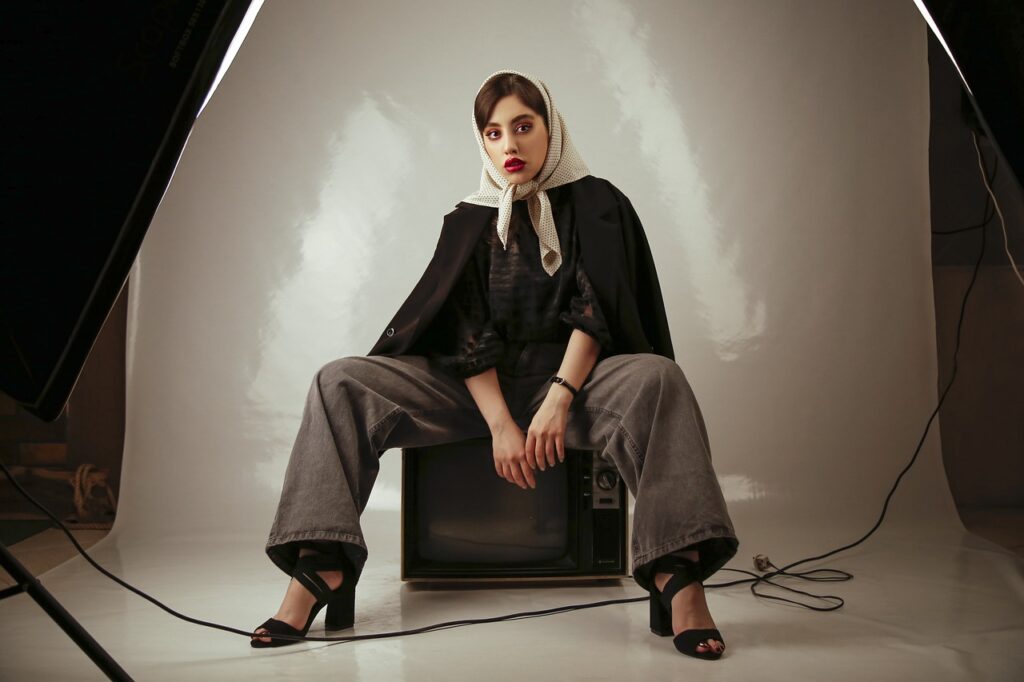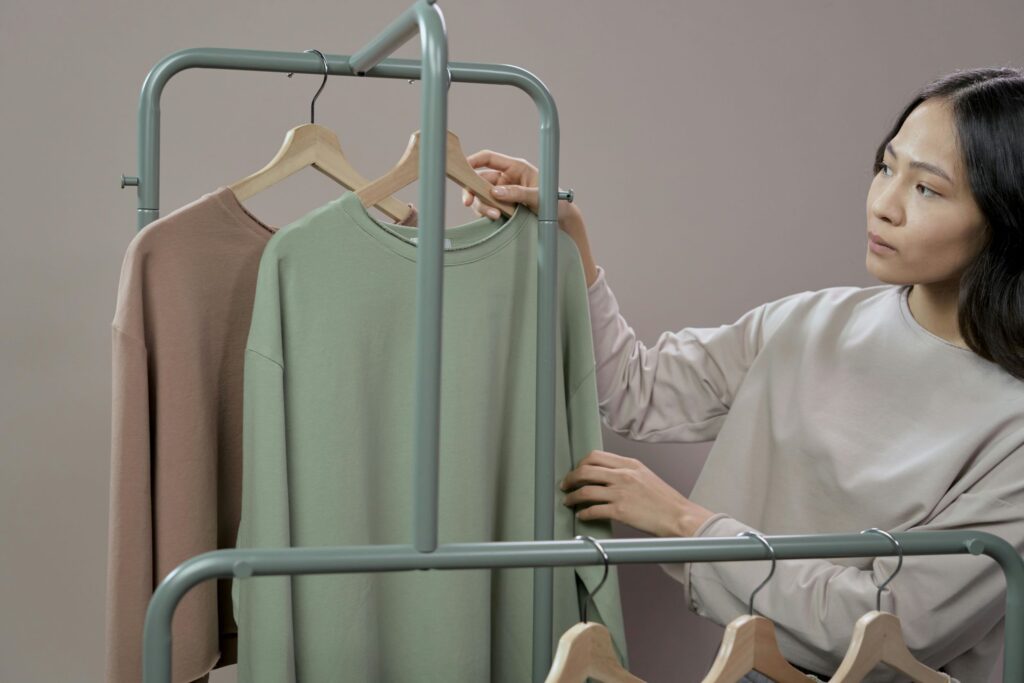Key takeaways
- Fashion merchandising is the umbrella term used to describe the process of planning, sourcing, and selling fashion products to meet consumer needs and desires.
- Students interested in the field can pursue an associate, bachelor’s, or master’s degree in the field, but a bachelor’s fashion merchandising degree is the ideal choice.
- Through the degree, students learn product development, illustration and design, merchandising principles, retail strategies, marketing and branding, and more.
- Students can pursue a Bachelor of Fine Arts in Fashion Merchandising, a Bachelor in Fashion Merchandising and Marketing, or a BBA in Fashion Merchandising.
- Fashion merchandising jobs you can get with a bachelor’s degree include Visual Fashion Merchandisers, earning an average salary of $65,682 per year as of October 2024.
- The projected job growth rate for jobs such as Buyers, and Purchasing Managers is 7%.
- Colleges offering fashion merchandising degrees include LIM College, Fashion Institute of Design and Merchandising, Marist College, and more.
- For an online fashion merchandising degree, explore Berkley College, Liberty College, Arkansas State University, and more.
Fashion enthusiasts who aspire to pursue a career in the fashion industry but do not want to be limited to roles such as fashion designer or stylist can explore a fashion merchandising degree. Fashion merchandisers are at the heart of the fashion industry connecting the latest fashion products with the right consumers.
Here, we discuss fashion merchandising in detail, from the types of degrees, and colleges you can explore to fashion merchandising jobs, salaries, market and industry trends, and more.
What is fashion merchandising?

Fashion merchandising is the strategic process of planning, sourcing, and selling fashion products to align with consumer demand. It requires a thorough understanding of market trends, consumer preferences, and the fashion industry.
Fashion merchandisers ensure that the right products are available at the right time, in the right quantities, and at the right price. This encompasses responsibilities such as product development, sourcing, pricing, promotion, and visual merchandising.
The ultimate goal of the merchandising process is to drive sales and profitability while delivering an enjoyable and effective shopping experience for customers. If you are interested in pursuing a career as a fashion merchandiser, a formal education is essential as the job role demands a diverse skill set.
What do you learn in a fashion merchandising degree?
A fashion merchandising degree is an amalgamation of a fashion and a business degree. Here students develop a combination of business, fashion, and practical skills, enabling them to take on a variety of roles in the fashion industry. Through the curriculum students learn:
- Product Knowledge
- Illustration and Design
- Merchandising Principles
- Retail Strategies
- Marketing and Branding
- Digital Technologies
Types of degrees in fashion merchandising
There are varying levels of education in the fashion merchandising industry that aspiring professionals can pursue. From associate degrees in fashion merchandising to a bachelor’s and then a master’s, students can pursue different types of degrees.
Associate degree in fashion merchandising
An associate degree is a two-year program that prepares students for a variety of entry-level positions in the fashion industry, or a bachelor’s degree. The degree focuses on the basic business aspects of the fashion industry.
Through the program, students can build a small portfolio allowing them to pursue job opportunities or further education. Potential job opportunities include Retail Sales Associate, Assistant Buyer, Social Media Coordinator, and so on.
Bachelor’s degree in fashion merchandising
A fashion merchandising bachelor’s degree is a four-year program that features an extensive curriculum. Through the program, students develop a wide range of skills and professional competencies that can open many career opportunities for graduates.
Potential job opportunities include Merchandise Planner, Visual Merchandiser, Fashion Journalist, Fashion Editor, and more.
Master’s degree in fashion merchandising
A master’s degree is ideal for those who want enhanced career prospects and are seeking upper managerial-level positions. It typically spans two to three years and prepares students for advanced roles.
These include but are not limited to Senior Merchandise Planner, Merchandising Director, Buying Director, Fashion Show Producer, Fashion Researcher, and more.
Bachelor’s degree in fashion merchandising – 1st step to a career in fashion merchandising
For aspiring fashion merchandisers, an associate’s or bachelor’s degree is an ideal starting point. Where an associate degree only focuses on the basics a bachelor’s degree offers a more comprehensive curriculum preparing students for a wider range of fashion merchandising jobs.
Bachelor of Fine Arts in Fashion Merchandising
A Bachelor of Fine Arts (BFA) in Fashion Merchandising is a degree program that combines the artistic aspects of fashion with the business and marketing knowledge necessary to succeed in the industry. It offers a comprehensive education in fashion design, merchandising, and retail management.
Bachelor of Fashion Merchandising and Marketing
A Bachelor of Fashion Merchandising and Marketing combines the creative aspects of fashion with the business and marketing aspects. The program focuses heavily on building competencies in marketing. It provides a comprehensive education in fashion design, merchandising, and retail management, along with marketing strategies to promote and sell fashion products.
Bachelor of Business Administration in Fashion Merchandising
A Bachelor of Business Administration (BBA) in Fashion Merchandising combines the artistic and creative aspects of fashion with business and management skills. It provides a comprehensive education in fashion design, merchandising, and retail management, along with a strong foundation in business principles.
Typical program curriculum of an undergraduate fashion merchandising degree
As mentioned earlier, a bachelor’s degree is a 4-year program and covers a wide range of subjects. The exact curriculum and choice availability varies by college, degree type, and program focus.
During the degree, students must complete a total of 120 credit hours minimum in order to graduate. They must take a combination of general, core, and elective courses to fulfill the program’s graduation requirements. These can include the following:
General courses:
- Business communications
- Public speaking
- Ethics and Professionalism
- Computer Applications
- Critical Thinking and Problem Solving
Core courses:
- Fashion History and Theory
- Textile Science and Design
- Color Theory and Application
- Fashion Illustration and Design
- Merchandising Principles
- Visual Merchandising
- Consumer Behavior
- Fashion Event Planning
- Fashion Forecasting
Business courses
- Business Administration
- Fashion Business Analysis
- Product Development
- Retail Management
- Interactive Fashion Communication
- Corporate Finance
- International Business
Marketing courses
- Principles of Marketing
- Promotion and Digital Marketing
- E-commerce and Marketing
Additionally, students will have to complete capstone projects and internship requirements in order to graduate. For example, Berkeley College requires students to complete a Fashion Innovation Capstone as part of its BBA in Fashion Merchandising graduation requirements.
The exact curriculum will vary by college and degree type. A BBA in fashion merchandising will include more business and management courses in combination with fashion merchandising courses.
Whereas a Bachelor of Fine Arts in Fashion Merchandising will focus more on the creative and artistic aspects of fashion merchandising. Similarly, a Fashion Merchandising and Marketing degree will feature many more marketing courses than business or management ones.
Give careful thought to program selection as your career opportunities largely depend on the skills learned.
Colleges offering a degree in fashion merchandising
The Fashion Institute for Design and Merchandising is one of the renowned colleges for fashion merchandising, but it is not the only great option. Here are some other colleges for fashion merchandising that you can explore.
| College | Acceptance % | Graduation % | Tuition |
| Fashion Institute of Technology | 52.8% | 84.2% | $6,170 in-state
$16,750 out-of-state |
| Academy of Art University | selective | 38% | $26,728 |
| LIM College | 84% | 53% | $30,610 |
| Kent State University | 88% | 64% | $12,464 in-state
$21,570 out-of-state |
| Marist College | 62.8% | 84.7% | $44,560 |
Fashion Institute of Design and Merchandise (FIDM) – Highlighted Option
The Fashion Institute of Design and Merchandise in Los Angeles California offers multiple fashion merchandising programs. Whether you are interested in marketing fashion merchandise or in merchandise product development, you will find an excellent academic program at FIDM in LA.
The college has an acceptance rate of 41.7% and a graduation rate of 88.4%. The average tuition fee at FIDM is $32,645. However, the figure may vary by program and degree level.
Can I pursue a fashion merchandising degree online?

Students looking for flexibility and convenience in their academic curriculum can consider pursuing a degree in fashion merchandising online. An online program essentially features the same curriculum as a traditional degree. However, there are just a few differences to consider before making a choice.
There are two types of online programs, synchronous, and asynchronous. Synchronous programs require students to stick to a schedule and attend classes in real-time, just virtually. Asynchronous programs offer a higher level of flexibility allowing students to take their classes anytime, anywhere.
If you are considering pursuing part- or full-time employment with your degree, consider an asynchronous fashion merchandising degree online. In fact, you might want to consider taking up a job side by side when enrolled in an online fashion merchandising degree as it will help you network and build industry connections.
Distance education learners require discipline, and excellent time management to successfully complete the program. Make sure you will be able to handle the noise and distractions that arise in the absence of a traditional classroom setting.
Colleges offering an online fashion merchandising degree
For those who value convenience, affordability, and flexibility, here are some colleges offering an online fashion merchandising degree.
| College | Acceptance % | Graduation % | Tuition |
| Berkeley College | 97% | 48.3% | $28,600 |
| LIM College | 83.8% | 53.2% | $30,610 |
| Arkansas State University | 70% | 55% | $7,456 in-state
$13,312 out-of-state |
| Liberty University | 99.3% | 28.9% | $22,511 |
| Central Michigan University | 91% | 63.4% | $13,650 |
What can you do with a fashion merchandising degree?

A fashion merchandising degree can lead to a successful career in the fashion industry as a merchandiser. People with an intrinsic creative ability, a knack for business, an eye for numbers, and a love for fashion are best suited for a career in the field.
Students enrolled in a fashion merchandising program develop diversified skills including business, management, marketing, and analytics. Additionally, students learn advertising, negotiation, pricing, and promotion. After graduation, they can pursue a variety of job opportunities.
Fashion merchandisers play a pivotal role in the creation and marketing of fashion products including clothing, houseware items, accessories, and beauty products. Graduates with fashion merchandising degrees work with fashion brands to help them develop products that will sell.
Those with an interest in marketing and retail can work with retailers in visual merchandise, sorting through the items to identify the ones that have the highest selling potential and crafting visually appealing displays to attract the right customers, at the right time.
However, a fashion merchandising degree does not limit career options. The degree features a combination of creative, business, and marketing courses. Students develop a varied skill set allowing them to pursue various opportunities including fashion merchandising jobs.
What fashion merchandising jobs can you take after graduation?
A formal education can prepare graduates for a variety of job roles. The program focuses on developing product development, research, marketing, market analysis, sales analysis, and data analytics skills along with honing a student’s creative abilities. The varied combination opens varied job roles for graduates with a degree in fashion merchandising.
Fashion Merchandiser
A Fashion Merchandiser is responsible for planning, developing, and implementing strategies to ensure the successful sale of fashion products. Their responsibilities include:
- Product Planning
- Inventory Management
- Visual Merchandising
- Sales Analysis
- Supplier Relations
Fashion merchandisers analyze market trends and customer preferences to identify product opportunities, track sales, and conduct data analyses for informed decision-making. They are responsible for controlling stock levels to optimize sales and minimize losses. Additionally, fashion merchandisers create visually appealing displays to attract customers.
Moreover, they build and maintain strong relationships with suppliers and customers. The average salary for a Fashion Merchandiser as of October 2024 is $65,682 per year.
Visual Merchandiser
A Visual Merchandiser is solely responsible for creating visually appealing displays to enhance customer’s shopping experience and increase sales. Their responsibilities include:
- Store Design
- Window Displays
- Product Presentation
- Color and Texture
- Trend Analysis
Visual merchandisers design and create store layouts and eye-catching window displays to attract customers. They are also tasked with the responsibility of arranging products in a visually appealing manner and with the right color palettes and materials to create a cohesive look.
A key responsibility of Visual Merchandisers is to stay up to date with the latest trends and incorporate them in the displays. The average salary for a Visual Merchandiser as of October 2024 is $62,072 per year.
Fashion Buyer
A Fashion Buyer is responsible for observing and reviewing consumer purchasing patterns, predicting future trends, and sourcing and purchasing clothing and accessories for a retail store or online shop. Their responsibilities include:
- Market Research
- Product Selection
- Negotiation
- Budgeting
- Quality Control
A fashion buyer identifies emerging trends and sources new suppliers. Based on their analysis, they select products that align with the brand’s aesthetic and target market. One key task for Fashion Buyers is negotiating prices and terms with suppliers. Moreover, they manage the buying budget and ensure profitability without compromising on the quality of products and adherence to brand standards.
The average salary of a Fashion Buyer as per the United Bureau of Labor Statistics is $77,180.
Department Manager
Department Managers are responsible for overseeing the day-to-day activities of a particular department within a store. Those with a fashion merchandising degree, are eligible to oversee the fashion department and their responsibilities include:
- Team Management
- Sales Performance
- Visual Merchandising
- Customer Service
- Inventory Management
- Operational Efficiency
Department Managers oversee hiring, training, managing a team of sales associates, driving sales, and achieving sales targets. Additionally, they are responsible for ensuring the department is visually appealing and well-organized, and providing excellent customer service to build customer loyalty.
Controlling inventory levels, minimizing stock loss, and implementing efficient processes to optimize operations also fall under a Department Manager’s responsibilities. The average salary of a Department Manager as of October 2024 is $57,988.
Assistant Buyer
An Assistant Buyer supports the buying team in sourcing and purchasing products. They help the buyer streamline the purchasing process ensuring efficient supply chain management. Their responsibilities include:
- Market Research
- Product Sourcing
- Sample Management
- Administrative Tasks
- Data Analysis
- Supplier Relations
Assistant Buyers identify trends, and potential suppliers, conduct in-depth research, and aid in sourcing new products. They manage sample requests and track samples, handling paperwork, purchase orders, and vendor communications. Assistant Buyers are also responsible for building long-lasting relationships with suppliers, negotiating terms of purchase, payment, and more.
Additionally, they analyze sales data to inform future buying decisions. The average salary of an Assistant Buyer is $62,430 per year as of October 2024.
Retail Manager
A Retail Manager oversees the day-to-day operations of a retail store. Their responsibilities are vast, but the main ones are as follows:
- Team Management
- Visual Merchandising
- Operational Efficiency
- Loss Prevention
- Customer Service
- Sales Performance
- Inventory Management
From hiring, training, and managing sales associates to ensuring they drive sales and meet sales targets, a Retail Manager oversees it all. Additionally, they control inventory levels, focus on minimizing stock loss, and implement efficient processes to optimize operations. They also implement effective measures to prevent theft and fraud. Moreover, they focus on building better customer relations.
The average salary of a Retail Manager as of October 2024 is $55,000 per year.
Merchandise Coordinator
A Merchandise Coordinator is responsible for ensuring product accuracy, customer satisfaction, and operational efficiency. Their responsibilities include:
- Product Information
- Inventory Management
- Purchase Orders
- Pricing and Promotions
- Visual Merchandising
- Data Analysis
- Customer Service
Merchandise Co-ordinators maintain up-to-date product information, and analyze sales data to identify trends. They address customer concerns and build customer relations. Additionally, they support visual merchandising efforts, assist in pricing and promotional strategies, process purchase orders, and manage inventory levels to ensure timely replenishment.
The average salary of a Merchandise Co-Ordinator is $52,209 as of October 2024.
Fashion Editor
A fashion editor oversees a team of creative professionals, including writers, photographers, designers, and stylists, to produce high-quality fashion content for magazines, newspapers, and websites. Their responsibilities include:
- Trend Forecasting
- Content Creation
- Photo Shoots
- Social Media
- Industry Networking
- Market Research
A fashion editor’s responsibilities include identifying emerging trends, staying informed about the latest fashion news and market developments, and writing insightful articles and reviews. They also plan and execute visually stunning photo shoots. A major part of their job includes engaging with the audience through social media and networking with industry professionals.
The average salary of a fashion editor as of October 2024 is $67,490.
Fashion merchandising industry trends and job market overview
The merchandising niche in the fashion industry attracts many aspiring professionals every year. However, the industry is also growing at an astounding rate. The projected fashion market revenue for 2024 is $770,99 billion and is set to grow with an annual growth rate of 8.94% as per a report by Statista.
The United Bureau of Labor Statistics also published its findings on careers in the fashion industry showcasing a positive outlook. The job growth rate of roles such as purchasing managers, buyers, and purchasing agents is 7%, which is higher than the national average for all occupations.
BLS also reports a total of 605,400 job openings for the above-mentioned roles annually. The positive job outlook is also backed by an attractive pay scale. In 2023, the median annual salary for Buyers and Purchasing Agents was $71,950, while Purchasing Managers earned a median annual salary of $136,380.
States with the highest fashion merchandising jobs
Here are the top 5 states with the highest employment opportunities for fashion merchandising jobs such as Buyers and Purchasing Agents.
| State | Employment | Annual wage |
| California | 47,150 | $ 84,510 |
| Texas | 38,650 | $ 75,570 |
| Florida | 27,570 | $ 72,660 |
| New York | 27,560 | $ 83,260 |
| Virginia | 21,960 | $ 88,270 |
Aspiring professionals looking for the ideal college to study fashion merchandising in one of the states with the highest employment opportunities can search for colleges by state.
Technology and its impact on the fashion merchandising industry
Technological innovations have taken the fashion industry by storm. From innovation in materials to Artificial Intelligence driving the fashion design industry, the changes are never-ending. However, the one that affects fashion merchandisers the most is the boom in e-commerce.
Technology has revolutionized the fashion industry, influencing both production processes and global trends. From manufacturing to marketing, technological advancements have shaped the way fashion is created and consumed.
Designers now leverage a diverse range of tools and techniques to bring their innovative visions to life, drawing inspiration from a vast array of sources. Moreover, as technology continues to evolve, its impact on the fashion world is only set to grow, promising a future of endless possibilities.
As an increasing number of consumers turn to digital technologies to find fashion items, the scope of fashion merchandising has expanded from traditional stores to e-commerce, social media, and more. Technology is not just changing the way fashion is marketed, but also how it is created, and where product developers draw inspiration from. Most importantly, it is causing a major shift in consumption patterns and consumer demand that fashion merchandisers must keep in mind.
Some frequently asked questions about fashion merchandising.

If you are interested in a career in fashion merchandising, you are sure to have a plethora of questions. Here are the answers to some frequently asked questions about the program.
How to become a fashion merchandiser?
To become a fashion merchandiser, the first step is to pursue a formal education. According to BLS, the majority of professionals in the merchandising niche in the fashion industry have a bachelor’s degree.
Additionally, students will have to work toward building a portfolio depicting their professional competencies before they graduate. They can do so by pursuing part-time employment during their degree, internships, participating in workshops, and competitions, and collaborating with peers on as many projects as possible.
Lastly, students must focus on networking and building connections and industry links. The better connected you are, the better it is for your professional career in the field of fashion. Your connections can help you access opportunities not available to the general public and get better deals.
Learn more about how to become a fashion merchandiser in our in-depth career guide.
What degree do you need for fashion merchandising?
A fashion merchandising degree is the ideal educational qualification for a successful career as a fashion merchandiser. However, it is not the only degree you can explore. Some alternate degrees for a career in the field include Fashion Media and Marketing, Fashion Designing, Fashion Journalism, Textile Design, and more.
Why fashion merchandising is important?
A Fashion Merchandiser’s end goal is to drive profitability, making it an essential role in the fashion industry. Their actions are focused on reducing losses, enabling stores and fashion manufacturers to be industry leaders, and enhancing profitability. Thus, their role in the professional market is incredibly important.
What does a fashion merchandiser do?
Fashion merchandisers are pivotal in the fashion industry. They predict future trends and ensure producers are producing items expected to sell well and that retailers have those products in store as a trend starts gaining momentum. They also ensure a store is well-stocked with items expected to sell well to ensure they don’t lose out on sales.
What is a fashion merchandiser?
A Fashion Merchandiser has a crucial role in the fashion industry, responsible for aligning product availability with consumer demand. They bridge the gap between design and retail by collaborating with designers, buyers, and retailers to create and implement successful product strategies.
How much does a fashion merchandiser earn?
The average pay scale for a fashion merchandiser in the United States as of October 2024, is $65,682 as per Pay Scale.
Enroll in a fashion merchandising degree today!
Join the fashion industry with the ideal skill set to help you excel in a variety of job roles with a fashion merchandising degree. Whether you aspire to become a fashion merchandiser, or a fashion editor, the comprehensive education received in a fashion merchandising degree can be an asset.
The Fashion Institute of Design and Merchandise is a renowned institute offering multiple merchandising programs for aspiring professionals. Kickstart your college application process with our AI Tools.
